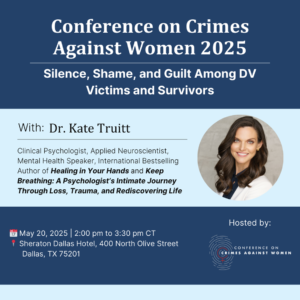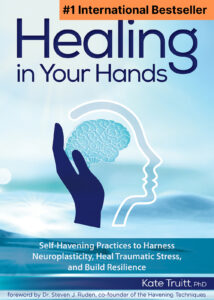Related Resources
For Managing Stress
What Is Post-Traumatic Growth?
If there’s post-traumatic stress, there’s also post-traumatic resilience. In this psychoeducation video, Dr. Kate Truitt discusses how neuroplasticity allows for the creation of post-traumatic resilience at a neurobiological level.
How Can Self-Compassion Letters Help Us Heal?
Self-compassion letters are a wonderful tool for healing, especially for the young wounded parts of us that never had the chance to feel loved and cared for as we were growing up. In this psychoeducational video, Dr. Kate explains how self-compassion letters can help us heal.
An Exercise for Immediate Anxiety Relief: CPR for the Amygdala®
In this guided meditation, Dr. Kate will demonstrate the process of Creating Personal Resiliency to help soothe your anxious brain. You will learn how to practice CPR for the Amygdala® to help you find a refuge from pain and anxiety and find peace within yourself.
When Trauma Becomes Your Story: How to Reclaim Your Identity After Abuse
By Dr. Kate Truitt
There is a subtle kind of loss that occurs when trauma becomes part of your story. It doesn’t always arrive loudly. Instead, it often seeps in quietly, reshaping how you see yourself and how you move through the world. For survivors of long-term abuse, the impact is often invisible to others but deeply felt within.
For many survivors, the question isn’t “Who am I?” but “Who did I have to become to survive?”
That question holds so much truth. It reflects the strength and adaptability that living through trauma often requires. But it also reveals the cost. When you live in an environment where fear, control, or chaos are constant, your identity begins to shift. Survival becomes the priority, and the brain, brilliantly designed to protect, steps in to help you adapt.
Maybe you became the peacekeeper, always putting others first to avoid conflict. Or the invisible one, trying to stay small to stay safe. Or the overachiever, hoping that perfection could create stability. These roles are not weaknesses. They are signs of your resilience.
But here’s what I want you to know. You are not your trauma. You are not the survival strategies you learned to stay safe.
How Trauma Encodes Identity: The Brain’s Story

Your brain is always listening. Always learning. Especially during moments of stress or fear. When we experience long-term trauma, particularly in the form of abuse, the brain begins to adapt in ways that prioritize safety above all else. This is not a flaw. It’s actually a powerful sign of how deeply your brain is wired to protect you.
Here’s the science: The amygdala, the brain’s threat detection center, becomes highly sensitized during chronic trauma. It scans for danger constantly, even when there is no immediate threat. At the same time, the prefrontal cortex, the part of the brain responsible for reasoning, self-awareness, and decision-making, may go offline under stress. This is because, in moments of perceived danger, the brain shifts into survival mode. It stops focusing on long-term thinking and instead activates immediate protective responses like fight, flight, freeze, or fawn.
Over time, the repeated activation of these survival circuits creates strong neural pathways. The brain becomes more efficient at responding with hypervigilance, self-silencing, or emotional numbness. These patterns, although once protective, can begin to shape how you see yourself and the world around you.
You may find yourself constantly on alert, even when nothing appears wrong. You might struggle to trust others or feel disconnected from your own emotions. Maybe you’ve learned to silence your needs or shrink your presence. These responses are not who you are. They are what your brain has practiced in order to survive.
This is the incredible part. The brain can learn, but it can also relearn.
Neuroplasticity is the brain’s ability to form new connections and change old patterns. With intention, safety, and compassionate practices, you can gently teach your brain a new way of being. You can begin to build new pathways rooted in self-worth, presence, and empowerment.
The Weight of Silence, Shame, and Guilt
Silence. Shame. Guilt. These emotions often take root so quietly that you may not even realize how deeply they’ve influenced your sense of self. For many survivors of abuse, these feelings become constant companions, woven into the fabric of daily life.
Silence can begin as a survival strategy. When speaking up leads to danger or rejection, the brain learns that staying quiet is safer. Over time, that silence can evolve into self-doubt and emotional suppression. You might begin to believe that your voice doesn’t matter, or that your truth is too much to be heard.
Shame is even more insidious. Unlike guilt, which says “I did something bad,” shame says “I am bad.” It convinces you that the abuse happened because of who you are, not because of what was done to you. In the brain, shame is linked to the same circuits that activate when we experience physical pain. It hurts. And the more you feel it, the more the brain reinforces that pattern, making it harder to see yourself through a lens of compassion.
Guilt can serve a healthy function when it helps us reflect on our actions. But in the context of abuse, guilt often becomes misplaced. Survivors may blame themselves for not leaving sooner, for saying the wrong thing, or for somehow not preventing the harm. These feelings are heavy, and they can keep you tethered to a past that was never your fault to carry.
If this resonates with your story or the story of someone you support, I invite you to join me for an upcoming workshop hosted by the Conference on Crimes Against Women designed to dive deeper into this very journey of healing and rewiring.
From a neuroscience perspective, these emotional patterns are tied to the brain’s limbic system, which stores emotional memory. When left unprocessed, the brain continues to react to reminders of past pain as if it is still happening now. This keeps the nervous system stuck in loops of fear, self-judgment, and emotional withdrawal.
But this is where healing begins.
When we start to name these emotions and understand their roots, we interrupt those old circuits. We create space for new ones. Through compassionate practices, like psychosensory touch or mindful journaling, you begin to teach your brain a new narrative — one that says, You are not to blame. You are worthy. You are safe now.
And when that shift begins, even in the smallest of ways, it opens the door to reclaiming your voice, your worth, and your identity.
Rewriting the Narrative: The Power of Neuroplasticity
Healing doesn’t mean erasing the past. It means reclaiming your power to write a new chapter. A chapter where you are no longer defined by what happened to you, but by who you choose to become now.
This is where the science of neuroplasticity offers both hope and evidence. Neuroplasticity is your brain’s natural ability to change and form new pathways throughout your life. That means even after years of living in survival mode, your brain can learn new ways of thinking, feeling, and being.
When trauma shapes identity, it does so by reinforcing the same neural circuits over and over again. The brain gets really good at activating fear, shame, or self-doubt because those were the most practiced responses. But here’s the empowering truth: you can teach your brain something new.
Here are a few everyday examples of neuroplasticity at work:
- Naming your emotions instead of ignoring them. Each time you pause and say, “I feel anxious right now,” you engage your prefrontal cortex, the part of your brain that helps you regulate emotion. Over time, this strengthens your ability to recognize and manage emotional states more effectively.
- Replacing self-critical thoughts with compassionate ones. If your brain automatically goes to “I’m not good enough,” you can gently introduce a new thought like, “I’m learning and growing.” The more consistently you do this, the more your brain begins to favor the compassionate pathway.
- Establishing safety rituals. Whether it’s placing a hand on your heart, creating a calming bedtime routine, or repeating an empowering affirmation, these small habits signal to your nervous system that you are safe now. And safety is the foundation for healing.
This doesn’t happen overnight. And it doesn’t need to. Change is built through small, consistent moments of kindness toward yourself. It might be a breath. A touch to the center of your chest. A whispered reminder that you are doing the best you can. These micro-moments of healing are powerful. They are how new neural maps are drawn.
The old story may still echo sometimes, and that’s okay. But over time, as you keep choosing yourself, the new story becomes louder. More familiar. More true.
You are not broken. You are becoming. In this psychoeducational video, I delve into post-traumatic resilience. You can be wiser and stronger after trauma. Just li Ike the phoenix, where one may burn up in the flames and rise again, you have the ability to create a space where you learn and grow from what has occurred.
And if you’re ready to take that next step in your healing journey, I invite you to explore Healing in Your Hands—my book, created as a compassionate guide for transforming trauma into resilience.
From Surviving to Thriving: Practical Tools for Reclaiming Self
Reclaiming your identity after trauma is not about rushing to feel better. It’s about creating space to reconnect with who you are beneath the pain. Small, intentional practices can help guide your brain away from survival mode and into a state of healing, empowerment, and self-trust.
Here are a few tools to begin that journey:
1. “Who Am I Becoming?” Journaling
When your sense of self has been shaped by trauma, writing can help you begin to reclaim your voice and story. Journaling offers a safe space to reconnect with your values, hopes, and authentic desires.
Prompt to explore:
What parts of me were hidden to survive? Who am I choosing to become now that I am safe enough to grow?
You don’t need all the answers right away. The act of asking is a powerful beginning.
2. Mirror Work for Self-Compassion
Looking into your own eyes with kindness can be surprisingly healing. Trauma often teaches us to turn away from ourselves, to avoid the mirror. Mirror work helps gently reverse that pattern.
Try this: Stand in front of a mirror, look into your eyes, and say something kind to yourself. It can be as simple as “I see you” or “You matter.” If it feels uncomfortable, that’s okay. With practice, your brain will start to believe it. Or you can also try writing yourself self-compassion letters.
3. Building Micro-Moments of Safety
Your brain heals through repetition. By creating small moments each day where you feel safe, connected, and calm, you’re reinforcing neural pathways that support your well-being.
Ideas to try:
- Wrap yourself in a blanket and take three slow breaths.
- Light a candle and sit quietly for one minute.
- Place a comforting hand on your chest and say, “This moment is mine.”
I invite you to try this guided meditation for immediate relief demonstrating the process of Creating personal Resilience to help soothe your anxious brain.
These tiny rituals may seem small, but they are powerful signals to your nervous system. They say, “I am here. I am safe. I am allowed to heal.”
Join Us: A Compassionate Workshop for Survivors
Healing is not meant to happen alone. Community, understanding, and science-informed support can make a powerful difference. That’s why I’m inviting you to join me for a special workshop designed to honor your journey and offer practical tools for moving forward.
This workshop explores how long-term trauma, especially domestic violence, shapes identity through patterns of silence, shame, and guilt. These emotional responses are not weaknesses. They are survival strategies that the brain develops to protect you. But over time, they can also keep you feeling stuck, unseen, or disconnected from your true self.
Through a trauma-informed and neuroscience-based lens, we’ll explore:
- How the brain encodes trauma and emotional pain
- Why shame and guilt often linger, even after the trauma ends
- Practical strategies for building self-compassion and emotional regulation
- Tools for reclaiming your voice, agency, and inner strength
Whether you are on the path of healing yourself or supporting others on theirs, this space is for you. You’ll leave with insights, tools, and most importantly, a deeper sense of hope. Because no matter how long trauma has shaped your story, there is always space for a new beginning.
Journal Prompt and Closing Reflection
Reclaiming your identity after trauma is a sacred, deeply personal journey. It requires tenderness, patience, and a willingness to meet yourself with compassion, even when it feels unfamiliar. You are not defined by what happened to you. You are defined by how you choose to heal.
Every tiny moment of kindness you offer yourself is a step forward. Every time you speak your truth, set a boundary, or rest when you need to, you are rewriting your story. These are not just acts of healing. They are acts of becoming.
You are not broken. You are becoming whole.
And as you continue on this path, here’s a gentle place to begin:
What parts of you are waiting to be rediscovered beneath the layers of survival?
What might it feel like to meet them with curiosity and compassion?
You deserve to know the truth of who you are, not through the lens of trauma, but through the eyes of love, strength, and possibility.
References
- Twin Branch Wellness. (2025, January). Reclaiming your identity after trauma. https://twinbranchwellness.com/blog/reclaiming-your-identity-after-trauma/
- Snow, J. (2020, December). Rewriting the narrative: 4 ways to reclaim your story after trauma. Psychology Today. https://www.psychologytoday.com/us/blog/bully-wise/202012/rewriting-the-narrative-4-ways-reclaim-your-story-after-trauma












